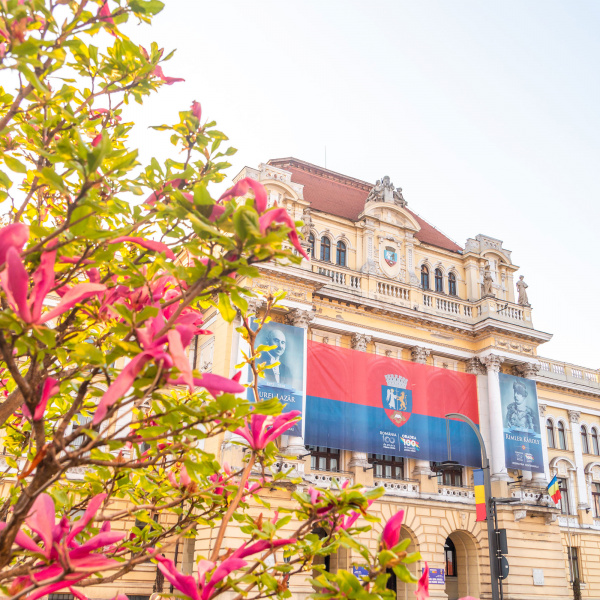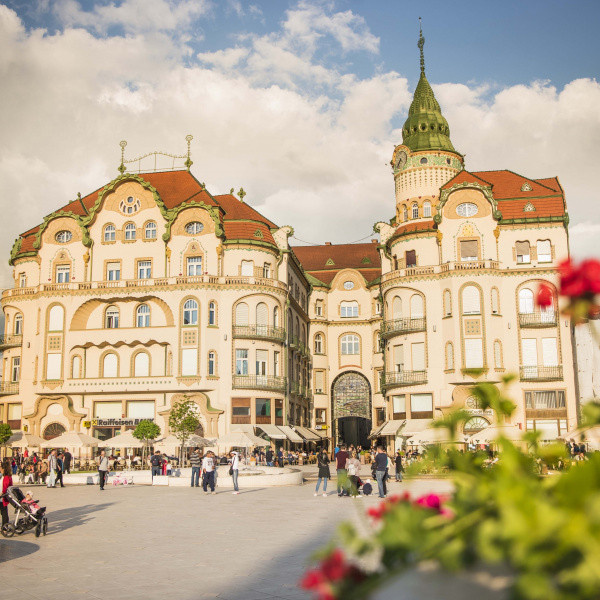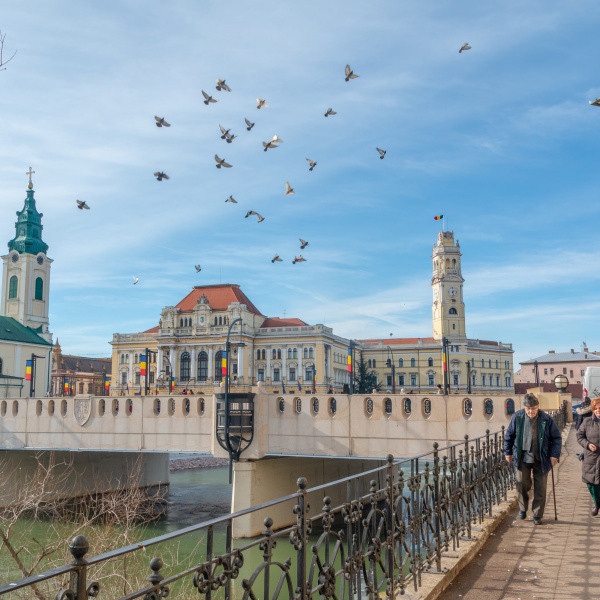Here you will find all the information you need to book a relaxing stay with family or friends!
Geography
Oradea is located between the hills that harmoniously bring together the Crişana Plain and the hilly-looking endings of Apuseni Mountains (Western Carpathians). Located on the banks of the river Crişul Repede, a river that divides the city into almost two equal halves, Oradea is the gateway to the Central and Western European world.
Geographically, the city is in the north-western part of Romania, at the intersection of the northern parallel 47°03' and the eastern meridian 21°55'. Oradea is located at about the same latitude as Nantes, Bern, Iași or Chișinău and on about the same meridian as Warsaw or the island of Zakynthos in Greece.
Located approximately 10 km from Borş, the largest crossing point on the western border of Romania, the city of Oradea is in tenth place among the cities of Romania, covering an area of 11,556 ha.
The landscape
The city is located at an altitude of 126m above sea level, in the opening area ofthe Crișul Repede valley, at the contact between the extensions of Apuseni Mountains and the extended Banat-Crişana Plain. The area is also a passage from the hills (Western Hills, Oradea Hills and Gepiş Hills) to the Pannonia plain.
Climate
Oradea has a temperate-continental climate with oceanic influences, determined by the persistence of westerly winds. The average multiannual temperature is 10.4˚C. For July, usually the warmest of the year, the average is about 21˚C, while in January, the coldest of the year, there is an average of -1.4˚C. One can say that you enjoy the sun many days during the year here, which can motivate you, even more, to venture on a trip to the Art Nouveau capital of Romania. Rain probability is relatively high, with an annual average of about 585.4mm, but these are variably distributed throughout the year.
Waters
Oradea is located on Crișul Repede river which crosses the city from east to west, with a rich network of rivers, brooks, and other tributaries in its basin, like Peța, Paris, Adona, Salbatic, and others. Crișul Repede passes right through the city centre, creating a meadow in the historic centre, which gives a special appeal to the whole area. Here you can enjoy a romantic dinner or a walk at sunset, with the murmur of water in the background.
Flora and vegetation
Due to the climate and geographical position, Oradea displays a very large variety of plants, from deciduous vegetation, like oak and beech forests, to vegetation specific for the meadow area such as wicker, willow, poplar, and alder.
Fruit trees are to be found both within the city, but also in the periphery area. Oradea has a significant horticultural and vineyard tradition, due to the natural slopes, exposed to the south and east. Convince yourself of the rich taste and freshness of fruits and vegetables, by visiting the grocery stores or markets in the city!
Fauna
The fauna is also specific to the intertwining of plain and hill areas. Thus, even inside the city of Oradea, in areas like the Dendrological Park no. 2, Podgoria Forest, Crișul meadow, Decantation Station, you will be able to admire rodent species such as hares; species of birds such as partridge, pheasant, seagull, summer swan, egret, cormorant, rooster, stork, mallard; or birds of prey, such as falcons and owls. Thus, Oradea is a friendly area for many wild animals and birds.
Thanks to Crișul Repede and its tributaries, you will also find many varieties of fish here, the most common being the chub, the nase, the crucian carp, the European bitterling, the rudd, or the pike.
The population
Perhaps the most significant historical gain of Oradea lies in its ethnic and confessional mix. It stands proof of the peaceful coexistence between the two majority ethnic groups - Romanians and Hungarians, along with the other minorities that make up the city's population.
According to the statistics resulting from the 2011 census, the population of the city on the banks of Crişul Repede counts 183,123 inhabitants, while the metropolitan area has 280,000 inhabitants.
In terms of ethnic distribution, there are 133,199 (70.4%) Romanians, 46,444 (27.5%) Hungarians, 773 (1.2%) Roma, 188 (0.3%) Germans, 477 (0.2%) Slovaks, with several other ethnic groups (Jews, Ukrainians, Bulgarians, Russians, Serbs, Czechs, Turks, Aromanians, Chinese).
From the confessional point of view, the inhabitants of Oradea are mainly Orthodox 109,585 (59.84%), followed by Roman Catholics 17,181 (9.38%), Greek Catholics 6,178 (3.37%), Reformed/Lutherans 26,124 (14 , 26%), Baptists 6813 (3.72%), Pentecostals 9229 (5.03), Seventh Day Adventists 566 (0.3%), Christian Gospel Church members 199 (0.09%), Evangelicals 115 (0 .05%), Muslims 132 (0.06%), Mosaic 174 (0.08%), and other religions 987 (1.94%).
Beyond these numbers there is a high level of interethnic and interfaith tolerance that Oradea is proud of, this diversity is one of the pillars of the city's development.
A brief history - Antiquity
Antiquity
The oldest evidence of inhabitation of the area was brought by a discovery made in 1909, in the perimeter of the former Knapp brick house, a bone deposit composed of 17 pieces, dating from the Upper Palaeolithic and belonging to various species of animals, signs of the presence of Homo sapiens presence on the current territory of Oradea, according to researchers.
Numerous discoveries belonging to the Neolithic period and then to those of bronze and iron have been found in various places in Oradea and its surroundings. From signs of Neolithic cultures such as Gheja, Coțofeni or Baden, through numerous ceramic pieces, to bronze ornaments of Ottoman culture, Bronze Age or treasures of gold objects, weapons and harnesses specific to the Iron Age - these artefacts can all be seen in Oradea City Museum (inside the Fortress) and beyond.
The ancient period is mainly marked by the Dacian civilization, its settlements being researched at Oradea-Salca II, on Dealul Viilor, Oradea-Sere, Ioșia, Seleuș. The period that followed the Roman conquest of Dacia is visible especially by the large number of coins found, a sign of an intense trade between the Romans and the free Dacians who occupied the area where Oradea is located today.
The period after the Roman retreat is followed by the succession of several waves of migrants, which will leave deep traces on the lives of the inhabitants, whether we are talking about Ostrogoths, Huns, Avars and Slavs. The presence of the latter in the Oradea area was established at the end of the seventh century (after 680), through the discoveries of necropolises containing pottery worked on a fast wheel.
If you are passionate about the ancient history of the surroundings, we invite you to book an afternoon for exploring the Fortress. Do not forget to check the operating schedule in advance, as well as the current events or exhibitions!
Middle Ages
The most consistent information about the history of the city and of Bihor county comes from the Chronicle of Anonymus, the Chronicle of Simon de Keza, the Registrar of Oradea, Carmen Miserabile and the Statutes of the Chapter of Oradea. According to another later source, the Painted Chronicle of Vienna (written during the second half of the fourteenth century), King Ladislaus I the Holy (1077-1095) "while being in the parish of the fortress of Bihor, between the rivers Criș, during a hunt, at the urging of the angels, he decided to build a monastery in honour of Virgin Mary in this place he called Varad”.
The first document of the city was recorded in 1113 in a diploma of Benedictine Abbey in Zobor.
Also, the toponym Oradea (Varadinum) is mentioned in a document regarding the repeated and destructive attacks of Moravian Prince Svatopluk on Vahului and Nitra Valley (Slovakia today). In the final part of the document, among them, those invoked, Bishop Syxtus Varadiensis and Committee Saul Bychar are remembered.
Unlike many other medieval cities that were born as a result of some foundations, Oradea was the result of an evolution that spanned a period of several centuries, culminating in the union into a single nucleus, in the middle of the 19th century, of all the settlements that arose around the fortress (Olosig, New City, Subcetate and Velenza).
Its development benefited greatly from the construction of the monastery, which would later become the seat of the chapter (college) composed of 24 canons. The same King Ladislaus will establish a diocese here, and at a distance of over a century from his death (occurred on July 25, 1095), he will be buried in the monastery built by his order in Oradea (somewhere around 1134).
The sanctification of King Ladislaus on June 27, 1192, marked a rapid rise for the existing ecclesiastical institutions in the city, attracting an increase in the social and economic importance of the settlements nearby the fortress built around the monastery.
Foto: Medieval Festival Oradea 2019
The great Mongol invasion and the fate of the city
An important event in the history of the city was the great Mongol invasion between 1241-1242, when part of the great army besieged the fortress, to later conquer and burn it. The event was recorded by the writings of monk Rogerius, who was in Oradea at the time.
Because the human and material losses were great after the Mongol withdrawal, the royalty encouraged massive colonisations around the monastery and the fortress, which led to the emergence of several settlements.
Starting with the end of the 15th century, the city will begin to receive several privileges from the royalty, which will be consistently reflected in its overall evolution. One of the most significant moments of this kind was the repopulation of the city and the granting of important economic benefits, after its destruction by the Ottoman armies at the beginning of 1474.
The economic development of the city will obviously be accompanied by a flourishing cultural life, felt especially with the penetration of the first ideas and habits of Humanism and Renaissance, coming from Italy during the time of Carol Robert de Anjou and Louis the Great.
At the beginning of the 16th century, the history of Oradea was marked by the battle of Mohacs in 1526, after which the Turkish troops managed to gain a crushing victory over the troops belonging to the Hungarian kingdom, King Louis II himself falling on the battlefield.
This defeat deeply shook the centre of the European continent, which allowed the Transylvanian voivodeship to intensify its independence tendencies, managing to establish itself as an independent voivodeship, after 1541. Three years later, Oradea and Bihor joined it.
The rise of the Ottoman Empire during the 16th century will not leave the history of Oradea untouched. The repeated attacks of 1598, 1658 and 1660 led to the domination of the city for more than 30 years, until 1692 when it was liberated by the Austrian army. This change marked the beginning of a new era in the life of the city and, at the same time, the administrative return to the Christian world of Europe.
For a more detailed series of events, we recommend that you ask for a guide or even a historian when you go to the museum. The stories about Oradea are numerous and interesting, and the guides' stories are full of humour and lessons.
Modern age
The cessation of armed confrontations led to the sustained development of economic life, dominated almost equally by agricultural and non-agricultural activities (in a mercurial from 1722, drawn up by Oradea local council, no less than 15 categories of craftsmen are identified).
The culture was not inferior during this period either. The new context allowed the emergence of representative personalities, such as Bishops Ignatius Darabant and Samuil Vulcan.
The ideas of the Enlightenment focused mainly on organizing a school network as large as possible and printing as many books as possible. In 1776 the Royal Academy appears at Oradea.
The revolutionary wave unleashed in Europe since the beginning of 1848 did not bypass Oradea either. Stage of intense activity of organizing the national guards and volunteers, workshops producing weapons and ammunition, but also of those who produced uniforms or shoes, Oradea will witness the repressive actions that followed the defeat of the revolution in 1848-1849. These actions led to the exile of many revolutionaries, but also to a policy for the city Germanization; process greatly facilitated by the significant presence of German craftsmen in the city.
In the middle of the 19th century, the 4 cities around the fortress (Oradea- Olosig, Oradea- Orașul Nou, Oradea- Subcetate and Oradea- Velența), with a total population of 16,849 united under a single administration. There is no official document to that effect, but the Habsburg authorities have appointed Bölönyi Menyhért as sole mayor.
During the second half of the 19th century, Oradea will experience sustained industrial development. Demographically, the city's population increased from 4,700 in 1814 to 40,750 in 1890. Growth continued during the next century. In 1910, their number was 64,169, and in 1914, 69,949.
From a municipal point of view, several achievements could be recorded throughout this period. There are new parks, such as the one created by reorganizing the banks of Crișul Repede, from the current Libertății square (1890-1892) or the one between the base of the hills and Crișul Repede river, next to Hotel Continental. Also, new buildings that complete the image of the city are built: Black Eagle Palace, the railway station building, the Premonstratensian Gymnasium and the Law Academy (Mihai Eminescu High School), the Royal State High School (Emanuil Gojdu High School ), the Post Office Palace, Pannonia Hotel), The City Museum, the two synagogues, the current Prefecture building, or Ullman Palace.
The Contemporary Age
By royal decree no. 2465 of September 25, 1925, Oradea was declared a municipality, and in 1930, the Heraldry Consultative Commission established the coat of arms of Oradea, with the following appearance: a blue shield with a silver Latin cross held to the left by a winged archangel, nimbus with gold, and to the right by a golden lion, crowned, raised on two paws, with a forked tail and a red tongue. The shield is stamped with a mural crown with seven towers.
The population continued to grow, and its structure by nationality, according to the 1930 census, was as follows: Romanian population - 27.7%, Hungarian population - 51%, and Jewish population - 17.7%. Other nationalities were German, Roma, Ruthenian or Ukrainian.
The outbreak of World War II will bring serious damage to Oradea, which the population will feel particularly acute, especially as a result of the Vienna Dictate, on the basis of which Hungary was ceded to the north-western part of Transylvania, including the territory of 42,243 with several cities, including Oradea.
The liberation of the city was prepared, in 1944, by the heavy battles that took place South from the city, during the first days of October, in the area of Păușa, Leș, Nojorid, Sânicolau Român, Berechiu and Roit localities. The decisive attack on Oradea took place on October 12.
On November 11, 1944, the Soviet military administration was established along with north-western Transylvania; and on March 9, 1945, after the establishment of Groza government, the Romanian administration was restored, thus inaugurating, unfortunately, the era of Stalinist communism.
The following period was marked by a forced industrialization policy, with profound implications in all sectors of public life. The lack and deprivation of liberties during the regime led to the protests of December 1989, which led to its fall.
A story perhaps too tumultuous for such a gentle landscape. Today's Oradea is a modern city in full development, being a landmark of local government and quality of life among Romanian cities.
Open to the new and modern, the city is twinned with a large number of cities around the globe, with which it maintains important connections in various fields: Debrecen (Hungary), Linkoping (Sweden), Coslada (Spain), Givatayim (Israel), Mantua (Italy), Ceyrat (France). In 2003, Oradea signed a Friendship Pact with Ivano-Frankivsk (Ukraine), and in 2006 a Cooperation Pact with Montbéliard (France).
If we aroused your interest in the history of Oradea and its surroundings, book a stay directly from our website!





/Festivalul_Medieval/MF1-700x400.jpg?token=4ea946d78bee0a928e0cda34ce89098f)
/Festivalul_Medieval/MF_10-700x400.jpg?token=302665d882be6616810fef9be6ca4746)
/Festivalul_Medieval/MF_11-700x400.jpg?token=c55ddea13dab991b6d4234f8e58b17db)
/Festivalul_Medieval/MF_12-700x400.jpg?token=7f28e3370d40b53ec206c52dfcc9e55c)
/Festivalul_Medieval/MF_13-700x400.jpg?token=803edbc79af72417feadb3036d774940)
/Festivalul_Medieval/MF_14-700x400.jpg?token=10d99642292b83287450a593c744298b)
/Festivalul_Medieval/MF_15-700x400.jpg?token=882320b330836ff07aec93e332d18252)
/Festivalul_Medieval/MF_16-700x400.jpg?token=8925612059e6cc3e6ed5bf2dc6fbd5bc)
/Festivalul_Medieval/MF_3-700x400.jpg?token=3df712bccc498c573a4944b05a4e4dfd)
/Festivalul_Medieval/MF_4-700x400.jpg?token=3d0a80d84c80618f4658b9a02231da6c)
/Festivalul_Medieval/MF_5-700x400.jpg?token=2843766fc19facf16b5f625ac901a564)
/Festivalul_Medieval/MF_6-700x400.jpg?token=fe0522cbd153674d935b6af9238ccdc0)
/Festivalul_Medieval/MF_7-700x400.jpg?token=1ad1f10c404c60f1a33bf7dbc86b579c)
/Festivalul_Medieval/MF_8-700x400.jpg?token=b3c9d4a5c7492150e7b2573d5302a64e)
/Festivalul_Medieval/MF_9-700x400.jpg?token=310dff8d7c25623d6db3e60b41b072e7)






















